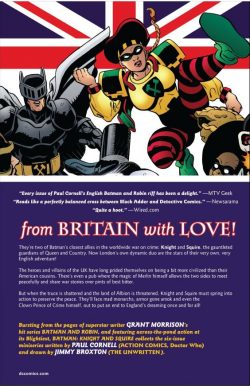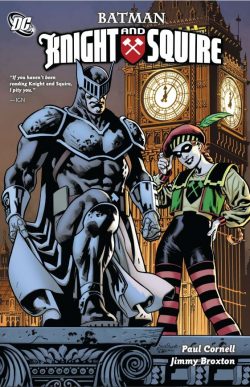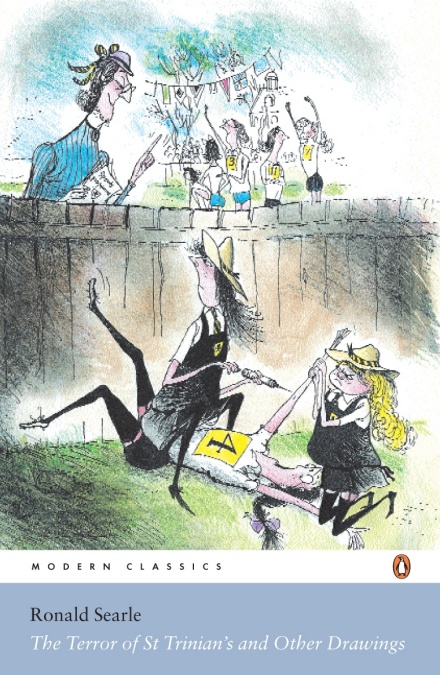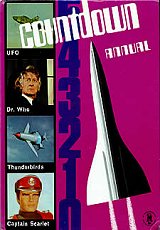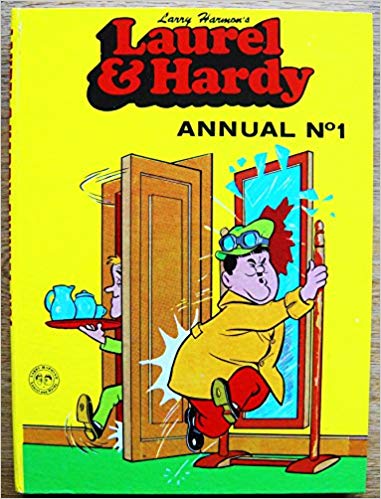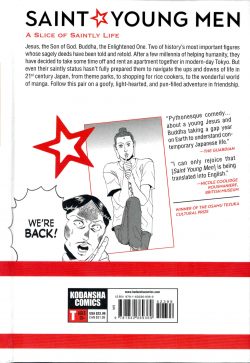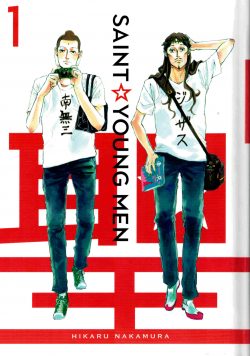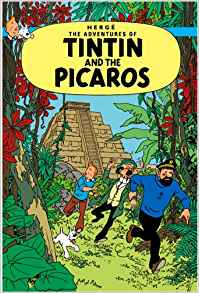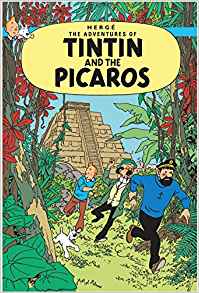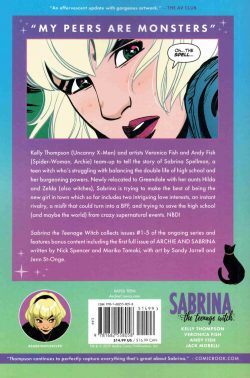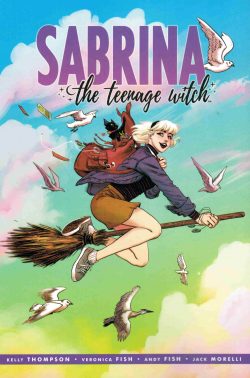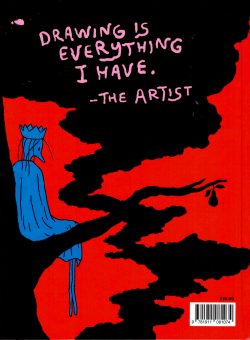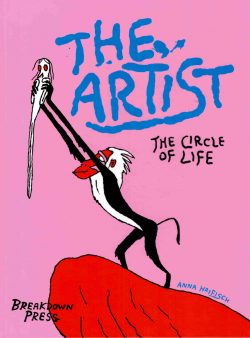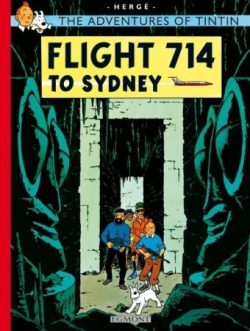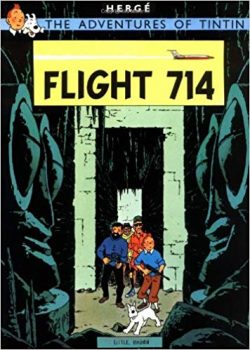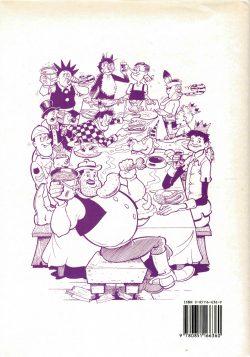
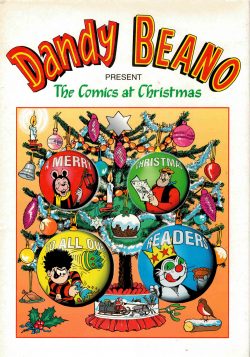
By many and various (D.D. Thomson & Co, Ltd.)
ISBN: 978-0-85116-636-0 (HB)
Win’s Christmas Gift Recommendation: Evergreen Seasonal Traditions Celebrated and Ideal Last-Minute Gifts… 10/10
DC Thompson’s publications have always played a big part in Britain’s Christmas festivities, so let’s revel in the Good Old Days of comics and look at what their publications have offered to celebrate the season via a lovingly curated accumulation of Scotland’s greatest cartoon stars and artisans…
Released in 1997 as part of the DC Thomson’s Sixtieth Anniversary celebrations for their children’s periodicals division – which has more than any other shaped the psyche of generations of kids – this splendidly oversized (297 x 206mm) and exceedingly jolly 144 page hardback compilation justifiably glories in the incredible wealth of ebullient creativity that paraded through the flimsy colourful pages of The Beano and The Dandy during the days and weeks of December from 1937 to the end of the century.
Admittedly the book needed some careful editing and paste-up additions whilst editorially explaining for younger or more socially evolved readers the subtle changes in attitude that have occurred over more than half a century, to tone down or expurgate a few of the more egregious terms that wouldn’t sit well with 21st century sensibilities, but otherwise this is a superb cartoon commemoration of a time and state of mind that means so much to us all.
It’s also an exquisitely evergreen tribute to cartoon storytelling at its best…
The shape and structure of British kids’ cartoon reading owes a huge debt to writer/editor Robert Duncan Low (1895-1980) who was probably DC Thomson’s greatest creative find. Low began at the publishing monolith as a journalist, rising to the post of Managing Editor of Children’s Publications where he conceived and launched (between 1921 and 1933) the company’s “Big Five†story-papers for boys. Those rip-roaring illustrated prose periodicals comprised Adventure, The Rover, The Wizard, The Skipper and The Hotspur.
In 1936 his next brilliant idea was The Fun Section: an 8-page pull-out supplement for Scottish national newspaper The Sunday Post consisting of comic strips. The illustrated accessory premiered on 8th March and from the very outset The Broons and Oor Wullie – both rendered by the incomparable Dudley Watkins – were its unchallenged stars…
In December 1937, Low launched the DC Thomson’s first weekly pictorial comic. The Dandy was followed by The Beano in 1938 and early-reading title The Magic Comic a year after that.
War-time paper shortages and rationing sadly curtailed this strip periodical revolution, and it was 1953 before the next wave of cartoon caper picture-papers. To supplement Beano and Dandy, the ball started rolling again with The Topper, closely followed by a host of new titles such as Beezer and Sparky to augment the expanding post-war line.
Every kid who grew up reading comics has their own personal nostalgia-filled nirvana, and DC Thomson have always sagely left that choice to us whilst striving to keep all eras alive with the carefully-tooled collectors’ albums like this one.
These have all the appeal and panache of coffee-table art books; gathering material from nearly eight decades of publishing – including oodles of original art reproductions – but rather than just tantalising and frustrating incomplete extracts, here the reader gets complete stories starring immortal characters from comics and Christmas Annuals past…
Until it folded and was reborn as a digital publication on 4th December 2012, The Dandy was the third-longest running comic in the world (behind Italy’s Il Giornalino – launched in 1924 – and America’s Detective Comics in March 1937). Premiering on December 4th 1937, it broke the mould of traditional British predecessors by using word balloons and captions rather than narrative blocks of text under the sequential picture frames.
A monster success, it was followed eight months later by The Beano – which launched on July 30th 1938 – and together they completely revolutionised the way children’s publications looked and, most importantly, how they were read.
Over the decades the “terrible twins†spawned a bevy of unforgettable and beloved household names who delighted generations of avid and devoted readers, and end of year celebrations were blessed with extraordinary efforts in the weeklies as well as bumper bonanzas of the comics’ stars breathtakingly glamorous hardback annuals.
As WWII progressed rationing of paper and ink forced the “children’s papers†into an alternating fortnightly schedule: on September 6th 1941, only The Dandy was published. A week later just The Beano appeared. They only returned to normal weekly editions on 30th July 1949, and during the conflict the Annuals alternated years too.
This superb celebration of Celtic creativity is packed literally cover-to-cover with brilliant strips. The fun starts on the inside front with a riotous party scene featuring all the assorted favourites, illustrated by indisputable key man Dudley D. Watkins, followed by Korky the Cat frontispiece (by James Crichton?), and bombastic title page with western superman Desperate Dan standing in for Santa.
An introductory spread follows, re-presenting a manic Davey Law Dennis the Menace Christmas episode from the 1960s, as well as a quartet of Beano Christmas cards from the same decade, presaging a host of seasonally-themed comic strip offerings beginning with Dandy‘s Dirty Dick (by Eric Roberts) and guest star stuffed ‘Xmas Shopping with Biffo the Bear’ (probably David Sutherland) and Minnie the Minx (Jim Petrie) impatiently ransacking the house for her prezzies from the 1960s.
This book offers a selection of Christmas week front pages, beginning with The Beano #169, (cover-dated December 20th1941) featuring Reg Carter’s obstreperous ostrich Big Eggo getting well-deserved revenge via Xmas lights during a blackout, after which Colonel Crackpot’s Circus by Malcolm Judge and Sutherland’s Bash Street Kids frolic as a prelude to robot schoolboy Brassneck (by Bill Holroyd) demonstrating the meaning of the season in a savvy spin on A Christmas Carol…
Robert Nixon – or maybe Ron Spencer – detail how Indian scamp Little Plum gets a tree for the tribe whilst Ken Reid’s wild west rogue Bing-Bang Benny scores a free dinner from his worst enemies, before the triumphs of Roger the Dodgerare encapsulated in a multifarious montage of strips by Ken Reid, Barrie Appleby, Gordon Bell and others.
Dudley D. Watkins illuminates Desperate Dan’s attempts to enjoy a white Christmas and Davey Law details similar catastrophic capers for Dennis the Menace before Watkins reveals how the upper class live in a party favour from Beanostarring Lord Snooty and his Pals, after which ‘Jimmy and his Grockle’ – a kind of Doberman dragon – reap the reward for wrecking other folks’ presents. Illustrated by James Clark, the feature stems from Dandy in 1938, recycled from prose “Boys Paper†The Rover (where it was “Jimmy Johnson’s Grockle†in 1932).
Holroyd’s The Tricks of Screwy Driver (a junior handyman inventor of variable efficacy – especially in the holiday season) gives way to a Biffo front cover strip (from Beano #649; December 25th 1954) before the Bash Street Kids destroy the school concert and 1940s feudal adventurer Danny Longlegs (Watkins) delays his voyage East to share the Yule festival with an embattled knight.
A montage of Beano B-stars including Sammy Shrinko, Have-a-go-Joe, Little Nell and Peter Pell, The Magic Lollipops, Maxi’s Taxis and Rip Van Wink compliments a triptych of ’40’s Dandy strips Freddy the Fearless Fly (Allan Morley), Hair Oil Hal (by John Brown) and Sam Fair’s Meddlesome Matty to ease us into a section concentrating on gluttony and the big blowout as seen in Eric Robert’s hospital ward feast Ginger’s Super Jeep, Basil Blackaller’s Hairy Dan‘s saga of a stolen plum pudding and The McTickles (Vic Neill) salutary tale of an escaped Haggis.
A classic Korky the Cat Christmas yarn segues neatly into a Ken Reid fantasy romp starring Ali Ha-Ha and the 40 Thieves, after which The Smasher (Hugh Morren?) fights for his right to party as prelude to a look at a wartime classic.
Sam Fair was in always excoriating top form with the superbly manic Addie and Hermy – slapstick assaults on Adolf Hitler and Hermann Wilhelm Göring/Goering – and the selection here helped counter Home Front austerity by punfully positing how bad the German High Command were having it…
Football mad Ball Boy (Judge) and a vintage Desperate Dan strip lead to more Watkins wonderment in a double-length revel in Lord Snooty castle (and no, the topper-wearing posh boy was never the pattern for a certain over-privileged Tory lounging lizard!!! It’s just an uncannily creepy coincidence cum laude and example of life imitating art), before Colonel Crackpot’s Circus stages an encore and Billy Whizz (Malcolm Judge) finds time to attend many nosh-ups in one short day…
Odd couple Big Head and Thick Head (Reid again) work far too hard for their places at the youth club bash whereas the ever-ravenous Three Bears (Bob McGrath) literally fall into a festive feast but eternal loser Calamity James (Tom Paterson) loses out yet again, unlike Law’s Corporal Clott who manages to become a hero to his comrades by getting rid of Grinch-like Colonel Grumbly…
A 1940’s Biffo extravaganza starring the entire Beano cast takes us neatly into a rousing comedy romp starring wonderful Eric Roberts’ immortal rascal-conman Winker Watson, who saves his chums from being stuck at school over the holidays in a full-length fable…
What’s Christmas without loot? A host of comics stars weigh in on presents in a section that begins with the cover of The Dandy #358 (December 20th 1947) as Korky’s greed is aptly rewarded, before John Sherwood’s dreamer Les Pretend(He’s Round the Bend!) wakes up frustrated, Dennis the Menace turns unwanted gifts into offensive weapons and – from December 1950 – Hugh McNeil’s Pansy Potter, the Strongman’s Daughter gives Santa Claus an uncomfortable helping hand…
From 1987, Appleby’s unlovable infants Cuddles and Dimples wreck another Christmas before Desperate Dawg (by George Martin from 1973) uses canine ingenuity to pimp that legendary sleigh whilst Roger the Dodger outsmarts himself but still comes up trumps in the gift department.
Lassie-like wonder dog Black Bob was popular enough to support his own book series in the 1950s (illustrated by Jack Prout) and here traditionally rendered Black Bob the Dandy Wonder Christmas dog sees the hairy paragon raise the flagging spirits of a ward full of ailing bairns before Charles Grigg’s Prince Whoopee (Your Pal from the Palace and a strip that could be revived instantly for today’s more cynical, satire-saturated market) learns the downside of childish pranks, after which a tantalising photo feature on assorted Beano and Dandy figurines leads to a montage of ancient robot romps starring with Tin-Can Tommy, the Clockwork Boy (by the Dinelli Brothers and Sam Fair), featuring the mechanical misfit as well as his brother Babe and tin cat Clanky.
An extended Xmas excursion for Minnie the Minx and vintage larks with Keyhole Kate (Allan Morley), Gordon Bell’s Pup’s Parade starring the Bash Street Dogs and George Martin’s Sunny Boy – in Santa’s Grotto – bring us to another brilliant cover spread: this one for The Dandy #204, from December 27th 1941, with Korky losing out after trying to outsmart Santa…
A rare prose yuletide yarn starring sagacious moggy Sooty Solomon shares space with a Christmas comic caper concerning Raggy Muffin the Dandy Dog, after which Pleasant Presents presents a gaggle of want’s lists from the comics characters before the animal antics resume with doses of doggerel clipped from annual feature Korky’s Christmas Greeting and a lengthy yarn starring Gnasher and his pal Dennis the Menace.
Stocking stuffing and tree trimming occupy Roger the Dodger and Tom, Dick and Sally (Dave Jenner?) but Roy Nixon’s Ivy the Terrible is all about the packages before focus shifts to excerpts from other times of year beginning with Prince Whoopee’s bath day, Billy Whizz on ‘Shoesday’ and the April Fool’s Day cover for The Dandy #70, from 1939.
Following on ‘Sports Day’ is celebrated on the cover of Beano #465 (June 16th 1951) and Desperate Dan turns April 1stinto April dooms day before similarly wrecking Easter, Pancake Day and Bonfire Night in a mini marathon of smashing strips.
Equally tough and disastrously well-meaning, Pansy Potter in Wonderland makes herself persona non grata with fairy tale folk after which Lord Snooty and his Pals’ good deed results in a catastrophic ‘Biff-day’ and Dennis the Menace discover the joy of graffiti on ‘“Mark-it†day’.
The section concludes with a Big Eggo Beano cover (#321; November 1st 1947) on a windy day, allowing pint-sized dreamer Wonder Boy to aspire to Santa’s job whilst Billy Whizz gets a job in the old boy’s grotto and Bully Beef and Chips (Jimmy Hughes) inevitably clash at a party before Watkins delights in depicting Jimmy and his Magic Patch as the lad with a ticket to anywhere stumbles into a north pole plot to burgle Saint Nick.
Desperate Dan’s plans to play Santa are sabotaged by his niece and nephew before Sandy Calder’s acrobatic schoolboy avenger Billy the Cat stalks and brings to justice a thief who steals all the silver from Burnham Academy… and still gets back in time for the school Xmas party.
George Martin’s school master Jammy Mr. Sammy uses his phenomenal luck to deal with pranksters and thugs before Winker Watson fosters a festive feud between his teachers and a local police training college; Nixon’s Grandpa gets Gnomework at a local grotto and Ron Spencer’s bonny bouncing bandit Babyface Finlayson gets locked up to get stuffed, even as The Jocks and the Geordies go to war over sharing an Xmas party, courtesy of the unique Jimmy Hughes.
Hurtling towards the Eighth Day of Christmas, the last strips here focus on a Ha-Ha-Happy New Year! with a classic Korky confrontation, a harsh Hogmanay hash-up starring Corporal Clott and a frankly disturbing exploit of animal excess and conspicuous consumption from 1940s Bamboo Town as limned by Charlie Gordon.
Disaster-prone Dirty Dick shows Eric Roberts at his inspired best in a cautionary tale about resolutions first seen in 1963, allowing the Bash Street Kids and Grandpa to have the cacophonous last words in a brace of action-packed slapstick strips redolent of years more fun to come…
Sadly, none of the writers are named and precious few of the artists in this collection, but, as always, I’ve offered a best guess as to whom we should thank, and of course I would be so very happy if anybody could confirm or deny my suppositions. A marvel of nostalgia and timeless comics wonder, the true magic of this collection is the brilliant art and stories by a host of talents that have literally made Britons who they are today, and bravo to DC Thomson for letting them out to run amok once again.
This sturdy celebration of the company’s children’s periodicals division rightly revels in the incredible wealth of ebullient creativity that paraded through their back catalogue: jam-packed with some of the best written and most impressively drawn strips ever conceived: superbly timeless examples of cartoon storytelling at its best…
© D.C. Thomson & Co., Ltd. 1997. All rights reserved.
